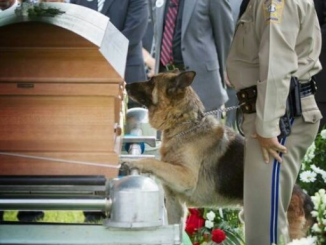
I’ve climbed thousands of trees. Oaks, pines, elms—some for work, some for fun, some because someone somewhere needed help getting their cat back. But that morning, when my phone rang and I heard the panic in the woman’s voice, something lodged itself in my chest.
“She hasn’t eaten in two days,” she sobbed. “She’s going to fall—I just know it.”
I tried to calm her down. “Is the cat yours?”
“No… I mean—she just showed up in our backyard two days ago. Then she climbed the old spruce. She hasn’t moved since. She looks terrified.”
I could picture it already. Cat stuck twenty feet up, neighbor too scared to climb a ladder, maybe I’d need my ropes if the tree was brittle. Standard stuff.
But when I pulled up in my old Ford and stepped into that quiet neighborhood, I immediately knew this was no ordinary call.
The tree was a giant. A sixty-foot spruce, thick with needles and lichen, branches twisting like old bones. And there, barely visible at the very top, was the cat—a black and white blur perched on the narrowest, highest limb. The kind of height that made your palms sweat just thinking about it.
“She hasn’t moved at all,” the woman whispered beside me. “She cries sometimes. Like she’s waiting for something.”
I nodded slowly, scanning the tree. No low branches, no easy access. I’d need to rig everything from the base, climb slowly, keep my weight centered. It would take time—and a whole lot of focus.
Thirty minutes later, I was halfway up, each branch moaning under my weight. The wind had picked up, the kind of breeze that whispers caution. I paused, heart pounding, and that’s when I heard it.
Not just a meow.
A wail. Long and low, not panicked, but desperate. It sent a shiver through me.
When I reached her, she didn’t move.
She looked me straight in the eye, fur bristling slightly, but made no effort to flee. I extended one hand and she crawled toward me, collapsed into my chest, and purred so violently I felt it in my ribs.
That’s when I saw it.
A ribbon—frayed and red, tied gently around her neck like a child’s bow. No collar. Just the ribbon. I brushed back her fur and squinted at the edge, where faint purple thread spelled out three tiny words:
PLEASE FIND ME.
My breath caught.
I descended as quickly as I could without risking a fall, clutching her like a precious thing. When I reached the ground, the woman looked confused.
“She’s okay?” she asked.
“Yeah,” I said quietly, “but this isn’t just a cat.”
I drove straight to the nearest vet. They scanned her for a chip, and a moment later, the receptionist looked up, wide-eyed.
“She’s registered. The name is Mara. Owners are Annette and Pascal Dumitru.”
I knew that name. Everyone in the area did.
Their daughter—seven-year-old Clara—had gone missing two weeks earlier.
I nearly dropped the cat.
The vet called the authorities immediately. Within the hour, I was speaking to two detectives in a dimly lit room while Mara lay curled in a towel nearby, still purring like nothing was wrong.
“The cat disappeared three days after Clara did,” one of the officers said, frowning at the notes. “They assumed she ran off.”
“But what if she didn’t?” I said. “What if she followed her?”
They both looked at me.
We pulled up satellite maps, forest access trails, and terrain overlays. Based on the direction Mara came from, we narrowed the area to a dense forest preserve six miles outside town. Officers organized a search party that evening.
They found Clara the next morning.
Huddled under a thick canopy of ferns and moss, half-covered in leaves, dehydrated and scared—but alive.
And Mara was with her.
The little girl had wandered too deep during a game of hide and seek at a family barbecue. She got lost, couldn’t find her way back, and ended up deep in the woods with nothing but the summer dress she’d been wearing and her cat.
“I told her to go find someone,” she said later from the hospital bed. “I told Mara to go.”
No one believed it at first. That a housecat could understand such a thing, could navigate miles of dense woods, could resist every instinct and find help.
But I did.
I believed it with every cell in my body.
I visited Clara a few days later. She was already up and walking around, her cheeks flushed with color again. Mara was in her lap.
“You’re the man who climbed the tree?” she asked.
“I am.”
She smiled softly, stroked Mara’s head. “She listened. I told her to find someone brave.”
I didn’t have a response to that. Not one that could match the gravity of what she’d survived.
Later that night, I walked to the spruce tree again. I stood beneath it and looked up at the branch where I’d found Mara.
The wind rustled the needles gently, and I could almost hear that soft purring echo again.
That day started like any other—a cat in a tree.
But it ended with a child saved, a town reunited, and a simple red ribbon that changed everything.
So now, every time someone calls me for a “routine rescue,” I don’t assume anything. I pack my gear like I’m heading into the unknown. Because sometimes, even the smallest cries for help hide the biggest stories.
And sometimes, you’re not just climbing to save a cat.
You’re answering a message.
A message stitched in purple thread, carried through wind and fear and branches that sway like the breath of the earth.
PLEASE FIND ME.
And maybe, just maybe, you’re the one who’s meant to answer it.
Would you have climbed sixty feet for a cat?
If this story moved you, share it. Someone out there might need a reminder: not all heroes wear capes. Some carry ropes, answer calls—and follow the cries that others can’t hear.






Leave a Reply